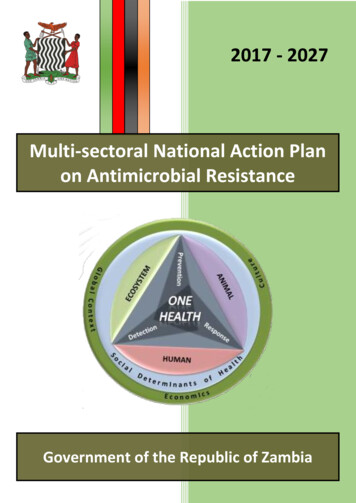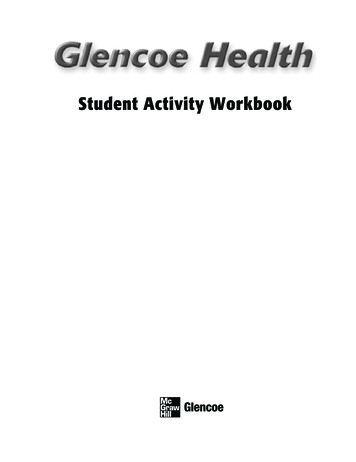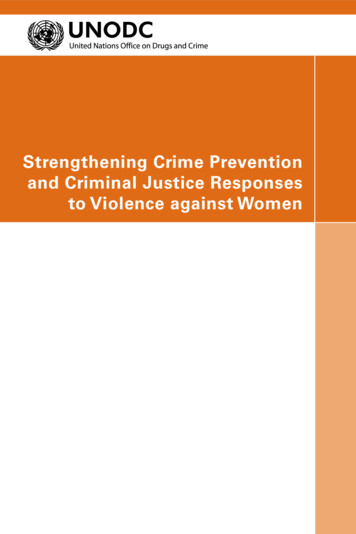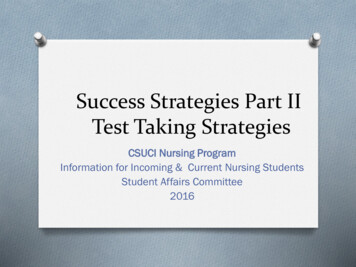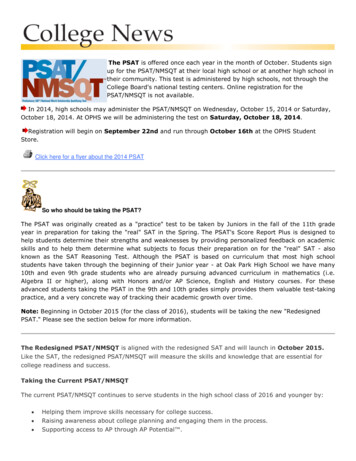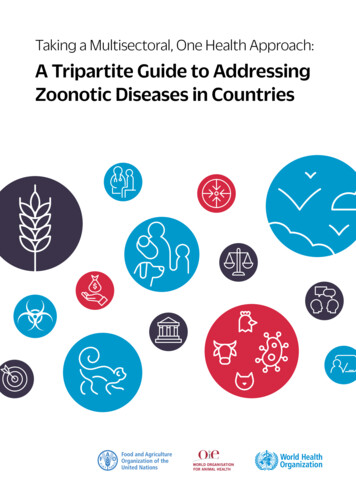
Transcription
Taking a Multisectoral, One Health Approach:A Tripartite Guide to AddressingZoonotic Diseases in Countries
Taking a Multisectoral, One Health Approach:A Tripartite Guide to AddressingZoonotic Diseases in CountriesPublished byThe Food and Agriculture Organization of the United Nations The World Organisation for Animal Health The World Health Organization 2019
Taking a Multisectoral, One Health Approach:A Tripartite Guide to Addressing Zoonotic Diseases in Countries World Health Organization (WHO), Food and Agriculture Organization of the UnitedNations (FAO) and World Organisation for Animal Health (OIE), 2019.ISBN: 978-92-4-151493-4 (WHO)ISBN: 978-92-5-131236-0 (FAO)ISBN: 978-92-9-511504-0 (OIE)All rights reserved. WHO, FAO and OIE encourage the reproduction and disseminationof material in this information product. Any proposed reproduction or dissemination fornon-commercial purposes will be authorized free of charge upon request, provided thesource is fully acknowledged. Any proposed reproduction or dissemination for resale orother commercial purposes, including educational purposes, is prohibited without theprior written permission of the copyright holders, and may incur fees.Requests for permission to reproduce or translate WHO publications – whether for sale or fornon-commercial distribution – should be addressed to WHO Press through the WHO t form/en/index.htmlThe designations employed and the presentation of material in this publication donot imply the expression of any opinion whatsoever on the part of the World HealthOrganization (WHO), the Food and Agriculture Organization of the United Nations (FAO)or of the World Organisation for Animal Health (OIE) concerning the legal status of anycountry, territory, city or area or of its authorities, or concerning the delimitation of itsfrontiers or boundaries. Dotted and dashed lines on maps represent approximate borderlines for which there may not yet be full agreement.The mention of specific companies or products of manufacturers, whether or not thesehave been patented, does not imply that these are or have been endorsed or recommendedby WHO, FAO and OIE in preference to others of a similar nature that are not mentioned.The published material is being distributed without warranty of any kind either expressedor implied. The responsibility for the interpretation and use of the material lies with thereader. In no event shall WHO, FAO and OIE be liable for damages arising from its use.The views expressed herein are those of the authors and do not necessarily representthose of WHO, FAO and OIE.Publications of the World Health Organization are available on the WHO web site(www.who.int) or can be purchased from WHO Press, World Health Organization,20 Avenue Appia, 1211 Geneva 27, Switzerland (tel.: 41 22 791 3264; fax: 41 22 791 4857;email: bookorders@who.int).FAO information products are available on the FAO website (www.fao.org/publications)and can be purchased through email (Publications-sales@fao.org).Publications of the World Organisation for Animal Health are available either on the OIE web site(www.oie.int) or can be purchased through the OIE online bookshop (www.oie.int/boutique).Taking a Multisectoral, One Health Approach:A Tripartite Guide to Addressing Zoonotic Diseases in Countries
ForewordEvery day we hear about health challenges at the human-animal-environment interface.Zoonotic diseases such as avian influenza, rabies, Ebola, and Rift Valley fever, as wellas food-borne diseases and antimicrobial resistance, continue to have major impactson health, livelihoods, and economies.Many countries recognize the benefits of taking a One Health approach that ismultisectoral and multidisciplinary to build national mechanisms for coordination,communication, and collaboration to address health threats at the human-animalenvironment interface. A One Health approach is also important for national andglobal health security, in implementing the World Health Organization (WHO)International Health Regulations (2005) and the international standards in animalhealth, veterinary public health, zoonotic diseases and animal welfare developed bythe World Organisation for Animal Health (OIE), and to contribute to many of theSustainable Development Goals and the 2030 Agenda.The tripartite collaboration between the Food and Agriculture Organization of theUnited Nations (FAO), OIE and WHO reflects a longstanding and successful partnershipin taking a One Health approach to address the challenges to public health, animalhealth (both domestic and wildlife) and the environment facing the world today. In fact,the Tripartite advocates for effective multisectoral, multidisciplinary, and transnationalcollaboration at the local, national, regional and global levels.A multidisciplinary and multisectoral collaboration, through a One Health approach isrequired to effectively prepare for, detect, assess, and respond to emerging and endemiczoonotic diseases. However, external and internal health system evaluations continueto identify major gaps in capacity to implement multisectoral and multidisciplinarycollaboration within and between many countries, and countries are asking for supportfrom the Tripartite to fill these gaps. This guide is the response to those requests.To date, only one jointly-developed, zoonotic diseases-specific guidance documentexists: the 2008 Tripartite “Zoonotic Diseases: A Guide to Establishing Collaborationbetween Animal and Human Health Sectors at the Country Level”. This guide has beenused in WHO South-East Asia Region (SEARO) and Western Pacific Region (WPRO)countries when implementing One Health, multisectoral activities under the AsiaPacific Strategy for Emerging Diseases (APSED). A decade later, the Tripartite hasupdated and expanded the 2008 Guide to cover prevention, preparedness, detectionand response to zoonotic threats at the animal-human-environment interface in allcountries and regions, and to include examples of best practices and options based onthe experiences of countries. Although focused on zoonotic diseases, the 2019 Guideis flexible enough to cover other health threats at the human-animal-environmentinterface (e.g., antimicrobial resistance and food safety).For additional support to countries implementing the 2019 Guide, the Tripartite willdevelop Operational Tools to support implementation of each of the technical subjectareas within this guide, such as best practices in interagency cooperative action, datacollection and reporting templates, and model standard operating procedures.Taking a Multisectoral, One Health Approach:A Tripartite Guide to Addressing Zoonotic Diseases in Countriesiii
In implementing a multisectoral, One Health approach, the Tripartite recognizes thatwe do not yet always know the best way to build structures and systems to addresszoonotic diseases in every situation, given the wide scope of countries and contexts.In order to make these structures and systems, which may have evolved over timein response to needs and events (including crises), more sustainable and effective,we invite the users of this guide to implement activities in a manner that fits theirneeds, the national context, and the requirements interested or affected parties fromall relevant sectors.We are grateful to the many experts from throughout the world, and our dedicateddonors and other partners who have come together in the spirit of One Health tocontribute their time and energy to this guide. In essence, this guide is not onlyabout the implementation of a One Health approach but reflects the collective globalcommitment to using this multisectoral, multidisciplinary approach to address zoonoticdiseases and related health threats.We hope you find this guide useful and practical and look forward to additionaldiscussions on how it can be improved and strengthened in the future.Peter SalamaBukar TijaniMatthew StoneDeputy Director-General,Emergency Preparednessand ResponseAssistant Director-General,Agriculture and ConsumerProtection DepartmentDeputy Director-General,International Standardsand ScienceWHOFAOOIETaking a Multisectoral, One Health Approach:A Tripartite Guide to Addressing Zoonotic Diseases in Countriesiv
AcknowledgementsThe content of this document was developed by the Food and Agriculture Organizationof the United Nations (FAO), the World Organisation for Animal Health (OIE), and theWorld Health Organization (WHO) (also known collectively as the Tripartite), includingtheir regional and country offices, in close collaboration with subject matter experts fromaround the world, as listed in [ CHAPTER 10 ] .The Tripartite gratefully acknowledges the enormous time and effort provided by theseexperts working in their individual and institutional capacities.The Tripartite also thanks the following partners and organizations for providing technicalassistance and/or in-kind funding and support for the development of this guide: UnitedStates Agency for International Development, United States Centers for Disease Controland Prevention One Health Office, United States Defense Threat Reduction Agency,Federal Republic of Germany, and the University of Minnesota.Taking a Multisectoral, One Health Approach:A Tripartite Guide to Addressing Zoonotic Diseases in Countriesv
Table of ContentsviiiQuick Start GuidexAcronyms01 1. Background02 1.1. Zoonotic disease threats03 1.2. A multisectoral, One Healthapproach05 1.3. Considerations for sustainabilityof implementation of a multisectoral,One Health approach08 1.4. Communication among andbetween stakeholders09 1.5. Social determinants of health09 1.6. Monitoring and evaluation11 2. About this guide12 2.1. Purpose12 2.2. Scope13 2.3. Use of this guide15 2.4. Regional considerations17 3. Multisectoral, OneHealth coordination18 3.1. Multisectoral, One Healthcoordination mechanisms21 3.2. Establishing a multisectoral, OneHealth coordination mechanism26 3.3. Ensuring sustainable coordination29 3.4. Technical coordination: Identifyingand implementing activities33 . Understanding national4context and priorities34 4.1. Mapping infrastructure and activities38 4.2. Identifying and analysing relevantstakeholders39 4.3. Prioritizing zoonotic diseases41 5. Taking a multisectoral,One Health approach tospecific technical activities42 5.1. Strategic planning and emergencypreparedness52 5.2. Surveillance for zoonotic diseases andinformation sharing63 5.3. Coordinated investigation and response71 5.4. Joint risk assessment for zoonoticdisease threats79 5.5. Risk reduction, risk communication, andcommunity engagement86 5.6. Workforce development93 . Monitoring and evaluating6implementation of theTZG in countries94 6.1. Using monitoring and evaluation tosupport and strengthen TZG activities94 6.2. Definitions95 6.3. Setting up a monitoring and evaluationsystem98 6.4. Conducting the monitoring andevaluation99 6.5. Example frameworks and indicators forM&E of the activities of the TZGTaking a Multisectoral, One Health Approach:A Tripartite Guide to Addressing Zoonotic Diseases in Countriesvi
109 7. Glossary00Figures115 8. Country experiencesviii 1. Quick Start Guide137 9. References and36 2. Growing with the One Health approachresources147 10. Contributors44 3. Elements of strategic planning63 4. Steps in setting up and undertakingcoordinated investigation and response70 5. Groups that may be established in anoperational response framework72 6. Steps in the joint risk assessment75 7. Example of a joint risk assessmentorganizational structure00Numbered boxes06 1. The Sustainable Development Goals,zoonotic diseases and the One Healthapproach07 2. INFOSAN encourages a One Healthapproach to food safety emergencyresponse31 3. Coordinating the activities describedin this guide43 4. Consolidation of zoonotic diseaseframeworks, plans, and strategiesTaking a Multisectoral, One Health Approach:A Tripartite Guide to Addressing Zoonotic Diseases in Countriesvii
QUICK START GUIDESpPrIdMappienngt ifior ity inaneczi nesFigure 1. Quick Start Guidei fi cte c h nic al avc tiit iesgzo o n o ti c d is e a ssgaernd aol dhen a ly sin g st a kdinfrastruc t u reTaking a Multisectoral, One Health Approach:A Tripartite Guide to Addressing Zoonotic Diseases in Countriesviii
QUICK START GUIDEUsing the TripartiteZoonoses GuideCHAPTERS 1 AND 2Background and About this guidep.01Quick overviews of each topic chapter CHAPTER 3 Multisectoral, One Health coordinationp.17CHAPTER 4: Understanding national context and prioritiesMapping infrastructure and activitiesp.34Identifying and analysing relevantstakeholdersp.38Prioritizing zoonotic diseasesp.39 bjectives at topO Best practice, and options where bestpractice is locally unsuitable Side menu lets you know: where you arein the guide and where you want to goto find linked informationThe definitions of words and phrases in thetext can be found in the glossary on page 109Boxes – different shape/color by type ofinformation in the boxKey ideas and Examples Best Practices and Options Objectives and BenefitsVery Important PrinciplesCHAPTER 5: Topic-Specific ActivitiesNumbered boxes: concepts referredto throughout the guideStrategic planning and emergencypreparednessp.42Surveillance for zoonotic diseasesand information sharingp.52Coordinated investigation andresponsep.63 Joint risk assessment for zoonoticdisease threatsp.71Risk reduction, risk communication,and community engagementp.79Workforce developmentp.86CHAPTER 6Monitoring and evaluatingimplementation of the TZG in countriesCross referencing uick start guide is linked to icons inQpage side menu References to chapters and sectionshighlighted in pink e.g. [ SECTION 3.1.1 ] References to country experiencesappear as superscript highlighted inblue e.g. (IN1; KH1) Country experiences can be found onpage 115 Acronyms and terms within the text aredefined in the acronym and glossarysectionsReminderp.93Taking a Multisectoral, One Health Approach:A Tripartite Guide to Addressing Zoonotic Diseases in CountriesThe TZG provides OPTIONS!Users of the guide decide on what theywill do based on context and needsix
AcronymsAARAfter Action ReviewAMRAntimicrobial ResistanceAPSEDAsia Pacific Strategy forEmerging DiseasesFAOFETPFETPVIHRIHR MEFINFOSANFood and AgricultureOrganization of theUnited NationsField EpidemiologyTraining ProgramField EpidemiologyTraining Program forVeterinariansInternational HealthRegulationsInternational HealthRegulations Monitoringand Evaluation FrameworkMoUMemorandumof UnderstandingM&EMonitoring and EvaluationNBWNational BridgingWorkshopsOH-SMART TMOHZDPOIEPVSOne Health SystemsMapping and ResourceToolkitOne Health ZoonoticDisease PrioritizationWorld Organisationfor Animal HealthOIE Performance ofVeterinary ServicesPathwayRARisk AssessmentSEAROWHO South-East AsiaRegional OfficeInternational Food SafetyAuthorities NetworkJEEJoint External EvaluationJRAJoint Risk AssessmentTZGTripartite Zoonoses Guide(Taking A Multisectoral, OneHealth Approach: A TripartiteGuide to Addressing ZoonoticDiseases in Countries)Monitoring and EvaluationFrameworkUSAIDUnited States Agency forInternational DevelopmentMiddle East RespiratorySyndrome CoronavirusUS-CDCMCMMEFMERS-CoVMultisectoral CoordinationMechanismMoAMinistry of Agriculture(as a shortcut for the nationalministry or agency/departmentresponsible for agriculture and/oranimal health)MoHMinistry of Health(as a shortcut for the nationalministry or agency/departmentresponsible for human/publichealth)Taking a Multisectoral, One Health Approach:A Tripartite Guide to Addressing Zoonotic Diseases in CountriesSDGSustainable DevelopmentGoalsUnited States Centersfor Disease Controland PreventionWHOWorld Health OrganizationWPROWHO Western PacificRegional Officex
1Background1.1. Zoonotic disease threats1.2. A multisectoral, One Health approach1.3. Considerations for sustainability ofimplementation of a multisectoral, OneHealth approach1.4. Communication among and betweenstakeholders1.5. Social determinants of health1.6. Monitoring and evaluation
1.Background1.1Zoonotic disease threatsZoonotic diseases, or zoonoses, are diseases shared between animals – including livestock,wildlife, and pets – and people. They can pose serious risks to both animal and humanhealth and may have far-reaching impacts on economies and livelihoods. Zoonoticdiseases are commonly spread at the human-animal-environment interface – where peopleand animals interact with each other in their shared environment. Zoonotic diseases canbe foodborne, waterborne, or vector-borne, or transmitted through direct contact withanimals, or indirectly by fomites or environmental contamination.Zoonotic disease threats include: zoonotic disease events and emergencies; endemic zoonotic diseases; new or emerging zoonotic diseases; other threats at the human-animal-environment interface such as antimicrobialresistance (AMR), food safety, and food security.Key principle of One Health within this Tripartite Zoonoses GuideIn the TZG, taking a multisectoral, One Health approach means that all relevant sectors anddisciplines across the human – animal – environment interface are involved to address health ina way that is more effective, efficient, or sustainable than might be achieved if not all relevantsectors were engaged. Taking a multisectoral, One Health approach includes ensuring balanceand equity among all the partners.Taking a Multisectoral, One Health Approach:A Tripartite Guide to Addressing Zoonotic Diseases in Countries2
1.Background1.2 A multisectoral, OneHealth approachHealth issues at the human-animal-environment interface cannot be effectively addressed 1by one sector alone. Collaboration across all sectors and disciplines responsible forhealth is required to address zoonotic diseases and other shared health threats at thehuman-animal-environment interface (1-12). This approach to collaboration is referred toas One Health.One Health is a collaborative, multidisciplinary, and multisectoral approach that canaddress urgent, ongoing, or potential health threats at the human-animal-environmentinterface at subnational, national, global, and regional levels. This approach includesensuring balance and equity among all the relevant sectors and disciplines 2.The multisectoral, One Health approachMultisectoral means that more than one sector is working together (e.g. on a joint program orresponse to an event), but does not imply that all relevant sectors are working together.Multidisciplinary means that multiple disciplines are working together (i.e. in a single ministry orresearch institute employing physicians, nurses, veterinarians, epidemiologists, laboratory scientists,basic scientists, and/or other health professions).A One Health approach always involves multisectoral collaboration, but the term multisectoraldoes not always mean that all relevant sectors, including the human health, animal health, andenvironment sectors, are engaged. Taking a One Health approach means that all relevant sectorsand disciplines are involved.1. To address means to prevent, detect, respond to, prepare for and assess, and reduce risks from zoonoticdiseases at country, regional and global levels.2. Relevant sectors are, at a minimum, those sectors, disciplines, stakeholders, or ministries that are essentialto addressing the health threat to be addressed using a multisectoral, One Health approach. Other sectors andagencies, including the private sector and academia, may be stakeholders to a particular health threat, and areincluded wherever needed.Taking a Multisectoral, One Health Approach:A Tripartite Guide to Addressing Zoonotic Diseases in Countries3
1.BackgroundMost countries have inadequate mechanisms in place for administrative and technicalcollaboration among the animal health, public health, and environment sectors and withother sectors and disciplines 3. In zoonotic disease events and emergencies, lack of joint preparation and establishedmechanisms for collaboration can result in confusion and delay responses, and canlead to poorer health outcomes. For endemic zoonotic disease threats, the lack of coordinated planning, informationsharing, assessment, and control activities across all relevant sectors can obstruct andcomplicate the implementation of effective disease control programmes.Benefits of an effectively-implemented multisectoral, OneHealth approach for zoonotic diseases R esponse to zoonotic disease events and emergencies is more timely and effective. A ll sectors have the information they need. D ecisions are based on accurate and shared assessments of the situation. A ccountability to each other and to decision makers ensures action by all sectors. Regulations, policies, and guidelines are realistic, acceptable, and implementable by all sectors. A ll sectors understand their specific roles and responsibilities in the collaboration. T echnical, human, and financial resources are effectively used and equitably shared. G aps in infrastructure, capacity and information are identified and filled. A dvocacy for funds, policies, and programmes is more effective.3. The lack of national mechanisms for taking a multisectoral, One Health approach for zoonotic diseases inmost countries is well recognized, and key elements for implementing effective interministerial collaborationwere identified during the Tripartite High Level Technical Meeting in Mexico in 2011 (13). Gaps in collaboration areoften identified in external assessments (14-15), (REG4; PK1; US1) and when responding to zoonotic disease events. (TZ1)Taking a Multisectoral, One Health Approach:A Tripartite Guide to Addressing Zoonotic Diseases in Countries4
1.Background1.3 Considerations forsustainability ofimplementation of amultisectoral, One HealthapproachIn some countries, a multisectoral, One Health approach has been effectively implementedto address a current zoonotic disease threat, then abandoned when the emergency is past.To ensure effective implementation of zoonotic disease control activities, this approachmust be made routine and sustainable.Key factors in sustainability include: political will: high level political will, and commitment and engagement from all therelevant sectors; (CM; MN2; TZ2; TH2) resources: sufficient and equitably distributed human and financial resources, fromdomestic sources; (BD1; IN1; QT4) c ontext: establishment of the activities within existing national infrastructure andconsidering national circumstances; (BD4; HT1; IN1) common goals: strategies and activities based on shared needs, common objectivesand health priorities, and having shared benefits; (US1) strong governance: strong national governance structures, aligned legal and policyframeworks and guidance, and compliance with existing regional and internationalstandards; (IT1) routine coordination: effective and routine coordination among all relevant sectorsfor planning and implementation; routine communication: effective and routine communication among all relevantsectors and at all appropriate levels for the national context; (JO1; KE2; CR1) s trong sectoral systems: strong and effective health systems within the individual sectors; r ecognizing successes: documented evidence of improved outcomes. (CA1)Taking a Multisectoral, One Health Approach:A Tripartite Guide to Addressing Zoonotic Diseases in Countries5
1.Background1.3.1 International and regional frameworksAligning with existing international and regional frameworks 4 can also promotesustainability of a national multisectoral, One Health approach for zoonotic diseases.Most countries work within one or more frameworks that require coordination acrosssectors and disciplines. Examples include the: International Health Regulations (16); OIE standards (17); Sustainable Development Goals [ BOX 1 ] ; (18); regional frameworks 5; Global Health Security Agenda (21); Codex Alimentarius (22); antimicrobial resistance frameworks (23-25); International Food Safety Authorities Network (INFOSAN); [ BOX 2 ] ; (26-27).Box 1: The Sustainable Development Goals, zoonotic diseases andthe One Health approachThe Sustainable Development Goals (SDGs) (18), entitled “Transforming our world: the 2030 Agendafor Sustainable Development”, aim to eradicate poverty and achieve sustainable development.These goals take an integrated approach, stress equity and sustainability, and are relevant toall countries. At national, regional and global levels, indicators for measuring progress towardsachieving the SDGs have become a priority for national governments.Taking a multisectoral, One Health approach for zoonotic diseases that addresses theinterconnectedness of health and its social and economic determinants aligns with the SDGframework. Health is a critical consideration in achieving the 17 goals, and taking a One Healthapproach in health activities will support making progress in achieving the SDGs. The SDGsthemselves reflect a One Health approach, ensuring that healthy people and animals live on ahealthy planet.Countries developing their zoonotic disease strategies will benefit from greater awareness andunderstanding of the synergies among zoonotic diseases, One Health, and the SDGs, and oflinking of SDG activities with planning processes, strategic plans, and M&E frameworks relatedto zoonotic diseases.4.Frameworks can also take the form of strategies, regulations, resolutions and codes of practice.5.e.g. APSED III, EU frameworks, PAHO Frameworks, AU-IBAR (18-19).Taking a Multisectoral, One Health Approach:A Tripartite Guide to Addressing Zoonotic Diseases in Countries6
1.BackgroundThe “Operational Framework for Strengthening Human, Animal and Environmental PublicHealth Systems at their Interface” (28), was released by the World Bank in 2018. Thisframework provides background on the origin, rationale and added value in taking amultisectoral, One Health approach, including a review of existing tools and processes (29).Other reviews of One Health-specific tools have been conducted (30-31), and an article iscurrently being prepared for the 2019 OIE Scientific and Technical Review that will provideadditional guidance for countries on uses and alignment of the various tools and resources.This Guide provides practical operational guidance and options for implementing nationalactivities to support these frameworks.Box 2: INFOSAN encourages a One Health approach to food safetyemergency responseLaunched in 2004, the International Food Safety Authorities Network (INFOSAN) is a globalnetwork of national food safety authorities from 188 Member States, managed jointly by FAOand WHO. The goal of INFOSAN is to prevent the international spread of contaminated food andfoodborne disease, and strengthen food safety systems globally by taking a multisectoral, OneHealth approach. This is done by: p romoting the rapid exchange of information during food safety events; s haring information on important food safety issues of global interest; p romoting partnership and collaboration between sectors, countries and networks; h elping countries to strengthen their capacity to manage food safety emergencies.Taking a One Health approach, the INFOSAN Secretariat encourages Member States to designateone emergency contact point from the national authority responsible for coordination during anational food safety emergency, as well as additional focal points from other national authoritiesthat have a role in ensuring food safety. Today, the network includes more than 600 membersfrom across a broad range of relevant sectors (e.g. human health, animal health, environmentalhealth, industry and trade, tourism). Active engagement with INFOSAN is one way to bolsterpreparedness for food safety emergency response, including emergencies involving outbreaksof foodborne zoonotic diseases.Taking a Multisectoral, One Health Approach:A Tripartite Guide to Addressing Zoonotic Diseases in Countries7
1.BackgroundCosts and benefitsTaking a multisectoral, One Health approach to zoonotic diseases makes the best use oflimited resources of money and personnel, improving the efficiency and effectivenessof zoonotic disease management, (CM2) so that costs are reduced. (IN1; CA3) Results may bemeasured simply as reduced morbidity and mortality, (CM2) or by cost-benefit analysesusing economic data [ SECTION 3.3.2; CHAPTER 6 ] ; (32).In addition to improved public health outcomes, strengthening systems and coordinationacross the human health, animal health and environment sectors can provide a strongreturn on investment. Costs are reduced by avoiding duplication of activities andperformance may improve by improving synergies – e.g. sharing of laboratory facilitiesby multiple sectors (33). (CA3) Reduced risks from zoonotic diseases also reduce indirectsocietal losses such as impacts on livelihoods of small producers, poorer nutrition, andrestriction of trade and tourism that, when included, bring the global costs of some recentzoonotic disease events to tens of billions of dollars (34).A multisectoral, One Health approach makes it easier to advocate for interventions thatbenefit all sectors but impose costs on only one (e.g., costs of vaccinating dogs againstrabies are borne by the animal health sector, but provide major public health benefits). Thevalue added for each of the sectors can justify investment in this approach to zoonoticdiseases, serve as an advocacy tool, and help policy-makers understand how costs andbenefits are shared across sectors.1.4 Communication amongand between stakeholdersContinuous, effective communication, across the government and within and amongpartner organizations and other relevant stakeholders, including media and the public,is necessary if zoonotic diseases are to be ad
One Health approach 08 1.4. Communication among and between stakeholders 09 1.5. Social determinants of health 09 1.6. Monitoring and evaluation 11 2. About this guide 12 2.1. Purpose 12 2.2. Scope 13 2.3. Use of this guide 15 2.4. Regional considerations 17 3. Multisectoral, One Health coordination 18 3.1. Multisectoral, One Health
